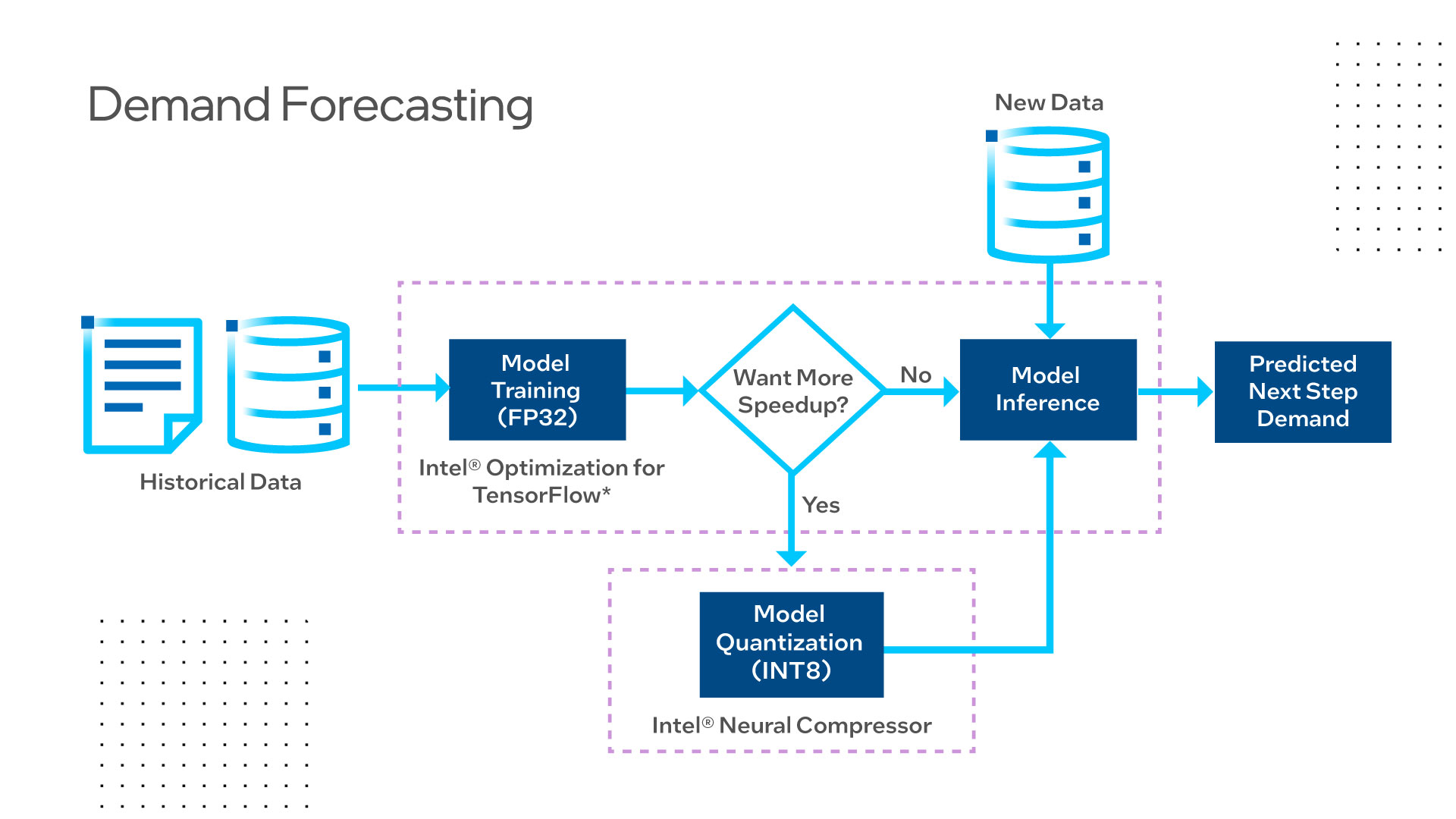Increase demand forecasting efficiency and accuracy with Intel® AI software products that trains deep learning models faster and with higher accuracy. Reduce inventory and forecasting error costs while optimizing stock replenishment, both of which can reduce enterprise total costs.
Background
Supply chain managers say that one of their top challenges is forecasting production to manage supply inventory and minimize lost sales due to lack of inventory. Poor forecasting can also lead to over-production, which then leads to excess inventory, resulting in additional costs for the enterprise and stock obsolescence. The abnormal spikes and dramatic drops in demand during the pandemic have increased interest in better demand forecasting tools for the enterprise.
AI-powered demand forecasting can help to reduce inventory forecast errors by up to 50 percent. The improved accuracy can lead up to a 65 percent reduction in lost sales due to inventory out-of-stock situations, and inventory reductions of up to 50 percent.1
Demand forecasting at scale is complex and involves using compute and memory-intensive deep learning to incorporate actual time-series data to model and predict future demand.
This AI reference kit helps your enterprise increase its demand forecasting capability. Intel software products deliver added efficiency by training complex AI deep learning models faster with higher accuracy to help reduce inventory and forecasting error costs, while optimizing stock replenishment management.

Solution
In collaboration with Accenture*, Intel developed an AI reference kit to help retailers forecast demand with a time-series prediction sequence modeling technique called convolutional neural network (CNN) long short-term memory (LSTM). CNN-LSTM is a highly complex deep learning technique where CNN is used to extract features of the input time data, while LSTM predicts the demand for the current day. This reference kit includes:
- Training data
- An open source, trained model
- Libraries
- User guides
- Intel® AI software products
At a Glance
- Industry: Retail
- Task: Train a time-series forecasting model to predict the demand of various products across various stores using historical data. Run inference to forecast demand for all the products across all of the stores.
- Dataset: Daily purchases
- Type of Learning: Unsupervised deep learning for time-series analysis.
- Models:
- Time-series prediction sequence modeling
- CNN-LSTM
- Output: Predict demand at the selected time for multiple products across multiple stores.
- Intel AI Software Products:
- Intel® Optimization for TensorFlow* with oneAPI Deep Neural Network Library (oneDNN)
This AI reference kit helps to accelerate the process of building an accurate and fast demand forecasting model capable of spanning multiple products and store locations. The experiment includes training a time-series forecasting model to predict the demand using historical data over five years.
Intel software products enhance the demand forecasting capability. They are optimized for performance so when paired with this reference kit, the result is faster training and faster inference results even for complex algorithms such as time-series prediction sequencing.
Technology
Optimized with Intel AI Software Products for Better Performance.
Intel Optimization for TensorFlow is optimized using oneDNN primitives for faster training and inference performance of highly complex deep learning, such as time-series prediction sequence modeling.
Performance was tested on Microsoft Azure* Standard_D4_V5 using 3rd generation Intel® Xeon® processors to optimize the solution environment.
Benefits
Traditional demand forecasting solutions often result in a trade-off between customer experience and inventory levels. Machine learning algorithms help enable new ways for the enterprise to maximize customer experiences by reducing out of stock incidents and inventory costs. Machine learning can do this by observing patterns not easily identifiable by humans.
To build a demand forecasting solution at scale, enterprise developers need to train hundreds of models for different products and or stores. The ability to forecast horizons faster and more accurately helps the enterprise to better manage the supply chain, and to deploy products more rapidly and at the scale of the entire catalog at different times.
When paired with Intel software products, the increased efficiency and accuracy of demand forecasting helps to reduce inventory and forecasting error costs while optimizing stock replenishment, both of which can reduce enterprise total costs.
References
- Smartening Up with Artificial Intelligence (AI) - What’s In It for Germany and its Industrial Sector? McKinsey & Company, 2017, https://www.mckinsey.com/~/media/McKinsey/Industries/Semiconductors/Our%20Insights/Smartening%20up%20with%20artificial%20intelligence/Smartening-up-with-artificial-intelligence.ashx%20str%209
